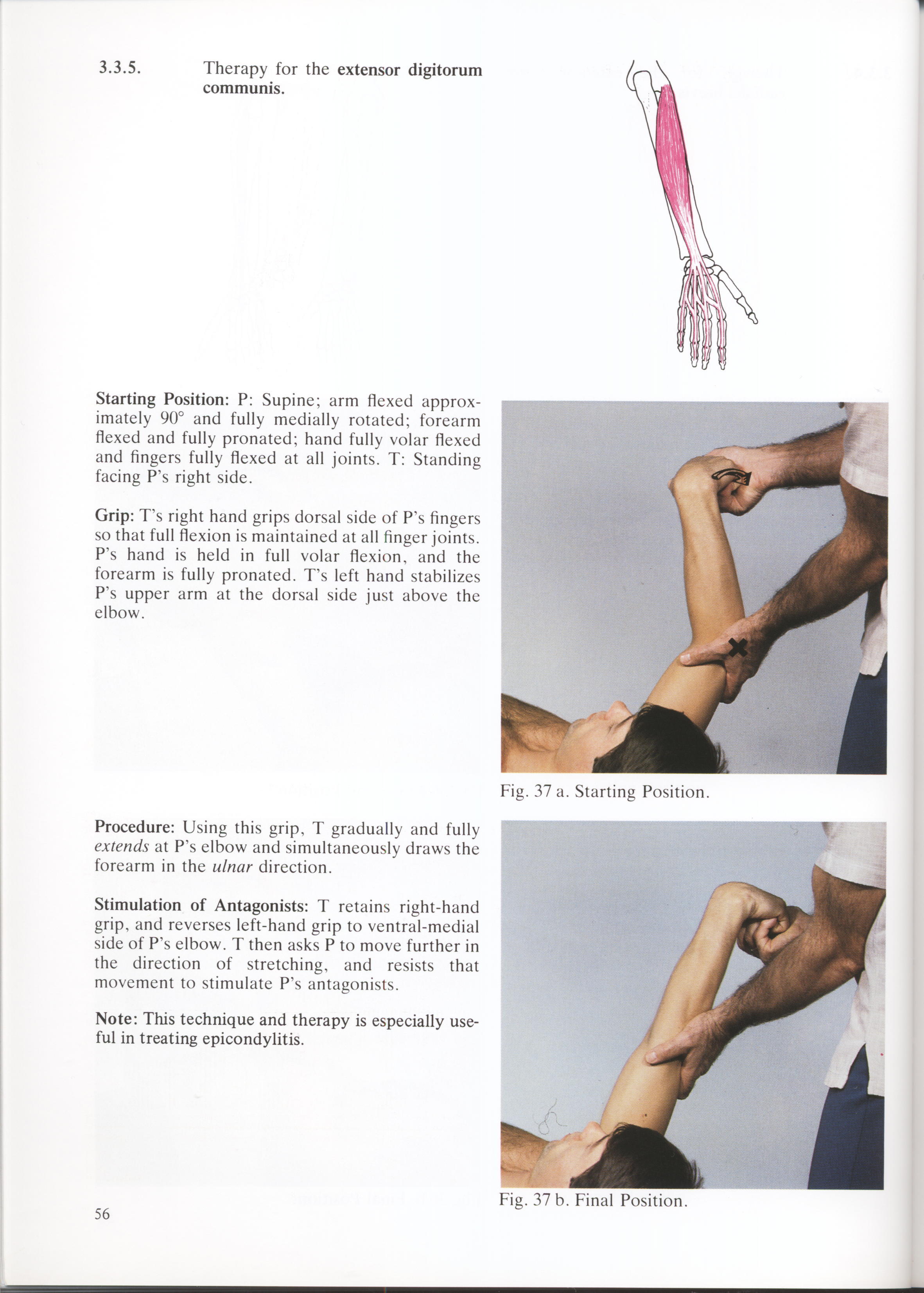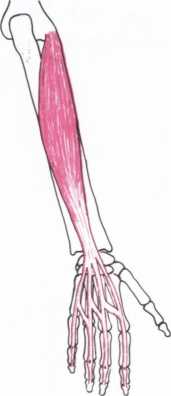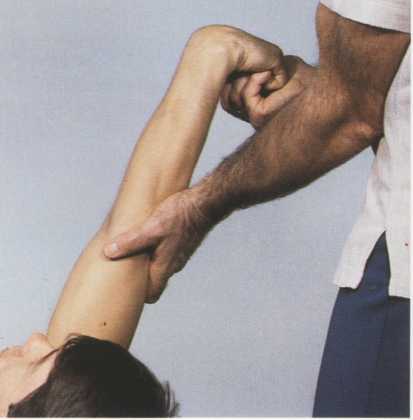55 (319)

3.3.5.
Therapy for the extensor digitorum communis.

Starting Position: P: Supine; arm flexed approx-imately 90° and fully medially rotated; forearm flexed and fully pronated; hand fully volar flexed and fingers fully flexed at all joints. T: Standing facing P’s right side.
Grip: Ts right hand grips dorsal side of P's hngers so that fuli flexion is maintained at all finger joints. P’s hand is held in fuli volar flexion, and the forearm is fully pronated. Ts left hand stabilizes P’s upper arm at the dorsal side just above the elbow.

Fig. 37 a. Starting Position.
Procedurę: Using this grip, T gradually and fully extends at P’s elbow and simultaneously draws the forearm in the ulnar direction.
Stimulation of Antagonists: T retains right-hand grip, and reverses left-hand grip to ventral-medial side of P’s elbow. T then asks P to move further in the direction of stretching, and resists that movement to stimulate P’s antagonists.
Notę: This techniąue and therapy is especially use-ful in treating epicondylitis.

Fig. 37 b. Finał Position.
56
Wyszukiwarka
Podobne podstrony:
58 (288) 3.3.8. Therapy for the extensor digiti minimi. Starting Position: P: Supine; arm flexed app
60 (279) 3.3.10. Therapy for the extensor carpi ulnaris. Starting Position: P: Supine; arm flexed ap
61 (266) 3.3.11. Therapy for the flexor carpi ulnaris. Starting Position: P: Supine; arm flexed appr
62 (264) 3.3.12. Therapy for the flexor carpi radialis. Starting Position: P: Supine; arm flexed app
69 (223) 4.2.1. Therapy for the extensor pollicis longus. Starting Position: P: Supine; upper arm an
74 (201) 4.5.2. Therapy for the extensor pollicis brevis. Starting Position: P: Supine or sitting; e
53 (314) 3.3.3. Therapy for the extensor carpi radialis longus. Starting Position: P: Supine; arm fl
54 (308) 3.3.4. Therapy for the extensor carpi radialis brevis. Starting Position: P: Supine; arm fl
59 (281) 3.3.9. Therapy for the supinator. Starting Position: P: Supine; arm flexed approx-imately 9
64 (249) 3.3.14. Therapy for the pronator teres, humerał head. Starting Position: P: Supine; arm fle
57 (309) 3.3.7. Therapy for the extensor digitorum communis. (Middle finger only). Starting Position
71 (222) Therapy for the flexor pollicis longus. Starting Position: P: Supine; upper arm and elbow r
73 (202) 4.5.1. Therapy for the abductor pollicis longus. Starting Position: P: Su
29 (669) 2.3.1. Therapy for the deltoid, spinał part. Starting Position: P: Supine; knees and hips f
80 (192) 5.3.1 Therapy for the flexor pollicis brevis. Starting Position: P: Supine or sitting; elbo
86 (164) 5.9.1. Therapy for the opponens digiti minimi. Starting Position: P: Supine or sitting; elb
45 (422) 2.12.2A. Therapy for the levator scapulae. SHH Starting Position: P: Supine; head and neck
72 (212) 4.4.1. Therapy for the flexor carpi ulnaris and the extensor carpi ulnaris. Starting Positi
32 (618) 1 2.3.4. Therapy for the trapezius, transverse part. Starting Position: P: Lying on left si
więcej podobnych podstron